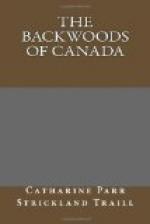The further we advance up the country the more fertile it appears. The harvest is ripening under a more genial climate than that below Quebec. We see fields of Indian corn in full flower: it is a stately-looking crop, with its beautiful feathery top tinted with a rich purple hue, below which tufts of pale green silk are waving in the breeze. When fully ripe they tell me it is beautiful to see the golden grain bursting from its silvery sheath; but that it is a crop liable to injury from frost, and has many enemies, such as bears, racoons, squirrels, mice, fowls, &c.
We saw several fields of tobacco along the banks of the river, which looked healthy and flourishing. I believe tobacco is cultivated to some extent in both provinces; but the Canadian tobacco is not held in such high esteem as that of Virginia.
There is a flourishing and very pretty town situated at the junction of the Richelieu river with the St. Laurence, formerly called Sorel, now called Fort William Henry. The situation is excellent. There are several churches, a military fort, with mills, and other public buildings, with some fine stone houses. The land, however, in the immediate vicinity of the town seems very light and sandy.
I was anxious to obtain a near view of a log-house or a shanty, and was somewhat disappointed in the few buildings of this kind that I saw along the banks of the river. It was not the rudeness of the material so much as the barn-like form of the buildings of this kind, and the little attention that paid to the picturesque, that displeased me. In Britain even the peasant has taste enough to plant a few roses or honeysuckles about his door or his casement, and there is the little bit of garden enclosed and neatly kept; but here no such attempt is made to ornament the cottages. We saw no smiling orchard or grove to conceal the bare log walls; and as to the little farm-houses, they are uglier still, and look so pert and ungraceful stuck upon the bank close to the water’s edge.
Further back a different style of building and cultivation appears. The farms and frame-houses are really handsome places, and in good taste, with clumps of trees here and there to break the monotony of the clearing. The land is nearly one unbroken level plain, apparently fertile and well farmed, but too flat for fine scenery. The country between Quebec and Montreal has all the appearance of having been under a long state of cultivation, especially on the right bank of the river. Still there is a great portion of forest standing which it will take years of labour to remove.
We passed some little grassy islands on which there were many herds of cattle feeding. I was puzzling myself to know how they got there, when the captain told me it was usual for farmers to convey their stock to these island pastures in flat-bottomed boats, or to swim them, if the place was fordable, and leave them to graze as long as the food continued good. If cows are put on an island within a reasonable distance of the farm, some person goes daily in a canoe to milk them. While he was telling me this, a log-canoe with a boy and a stout lass with tin pails, paddled across from the bank of the river, and proceeded to call together their herd.




